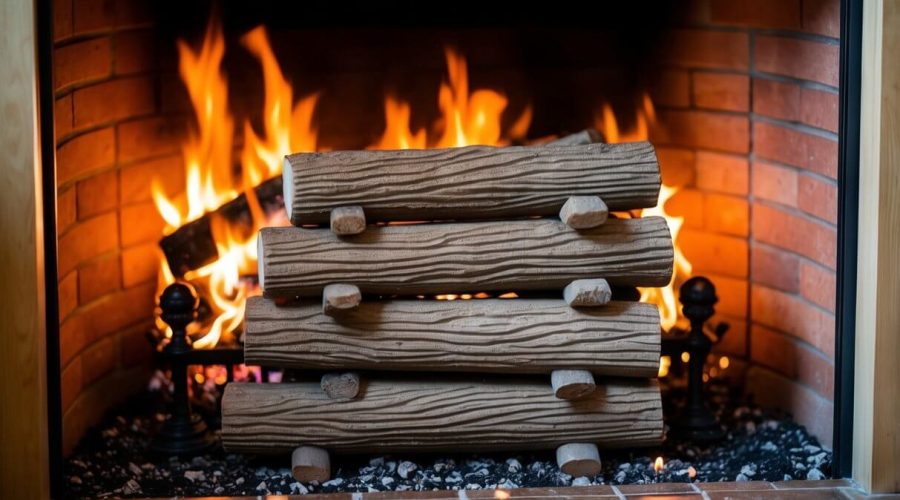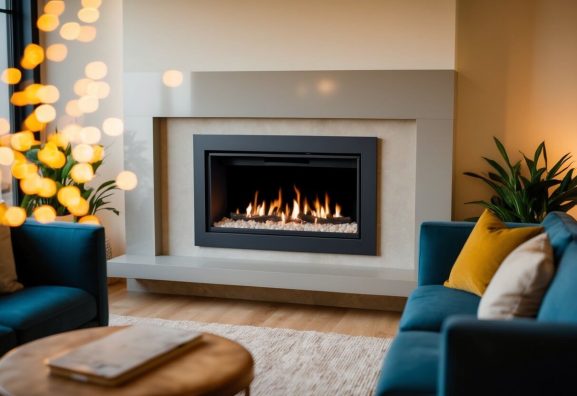What Are Gas Fireplace Logs Made Of?
Gas fireplace logs serve as a beautiful and functional element in modern homes, providing warmth and ambiance without the hassle of traditional wood-burning fireplaces. These logs are primarily made from materials such as refractory ceramic, ceramic fiber, and refractory cement, designed to mimic the appearance of real wood while offering enhanced safety and longevity. With the growing popularity of gas fireplaces, understanding what these logs are made of can help homeowners make informed decisions about their heating options.
When choosing gas logs, it is essential to consider both their aesthetic appeal and practical features. Gas logs come in various styles and materials to match different interior designs and preferences. The construction of these logs not only contributes to their realism but also influences their efficiency and operational safety, ensuring consistent warmth and a pleasant atmosphere.
The pursuit of a cozy environment can lead individuals to explore the myriad options available in gas fireplace logs. With the right choice, a gas fireplace can transform a living space into a comforting retreat, providing both visual charm and effective heating solutions.
Key Takeaways
- Gas fireplace logs are made from refractory ceramic, ceramic fiber, and refractory cement.
- They provide efficient heating while enhancing the ambiance of living spaces.
- Selecting the right logs can lead to better safety and operational effectiveness.
Types of Gas Fireplace Logs

Gas fireplace logs come in a variety of types designed to meet different heating needs and aesthetic preferences. Each type has its characteristics, benefits, and installation requirements that impact its performance and appearance.
Vented Gas Logs
Vented gas logs are designed for use in fireplaces with a chimney or venting system. These logs require proper ventilation to expel combustion gases, making them suitable for traditional masonry fireplaces.
They produce a more realistic flame and are often used for aesthetics, generating less heat compared to ventless options. Common materials include refractory ceramic and ceramic fiber, giving them a lifelike appearance.
Users can choose from various styles and configurations, including logs shaped like real wood types. Maintenance includes regular chimney inspections to ensure proper ventilation.
Ventless Gas Logs
Ventless gas logs, also called vent-free logs, operate without a chimney or venting system. They are specifically designed to burn fuel more efficiently, converting virtually all the gas into heat.
These logs can be installed in areas lacking traditional venting, such as apartments or smaller spaces. Made from fire-resistant materials, they provide significant warmth while enhancing the room’s ambiance.
Ventless systems often incorporate safety features like oxygen depletion sensors. However, they may produce minor combustion byproducts, which some users prefer to avoid.
Differences Between Vented and Vent-Free Logs
The differences between vented and vent-free gas logs primarily revolve around installation, heat output, and safety. Vented logs require a chimney, allowing for authentic flame aesthetics but resulting in less heat retention.
Conversely, vent-free logs function without a vent, maximizing heat output while minimizing installation complexities.
Safety is another factor; vented logs have fewer concerns about indoor air quality, while vent-free logs may require additional safety features to manage emissions. The decision between the two depends on heating needs, aesthetics, and the fireplace’s setup.
Materials and Construction
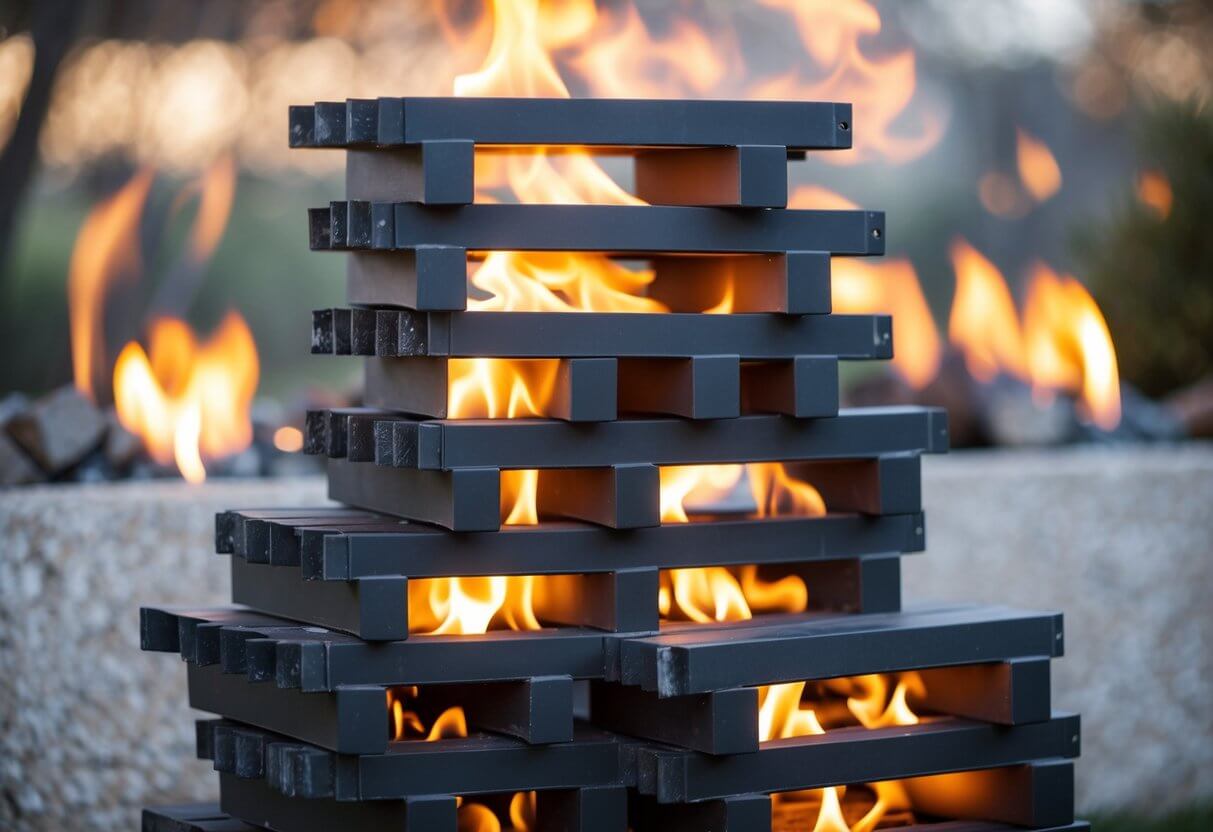
Gas fireplace logs are crafted from various materials that impact their durability, appearance, and heat efficiency. Understanding the differences in these materials helps in choosing the right logs for specific needs.
Refractory Cement Logs
Refractory cement logs are known for their exceptional heat resistance. This material can withstand high temperatures without degrading, making it suitable for continuous use in gas fireplaces.
These logs are often shaped to mimic real wood, enhancing the fireplace’s aesthetic appeal. They are ideal for homeowners seeking a realistic flame appearance combined with durability.
Refractory cement provides excellent thermal mass, allowing it to radiate heat effectively. Additionally, these logs are generally heavy, which aids in their stability within the fireplace setup.
Ceramic Fiber Logs
Ceramic fiber logs are lightweight yet robust, making them a popular choice among consumers. They are made from ceramic materials that can handle high temperatures while maintaining their structural integrity.
These logs typically offer a realistic wood-like appearance and are designed to provide efficient heat output. Their lightweight nature allows for easier installation and rearrangement within the fireplace.
Ceramic fiber logs are available in various styles, catering to different aesthetic preferences. Moreover, they are less prone to cracking compared to other materials when subjected to thermal stress.
Refractory Ceramic
Refractory ceramic logs combine the benefits of both durability and realism. This material features high heat resistance and excellent durability, ensuring a long service life in gas fireplaces.
Refractory ceramic logs radiate heat efficiently, providing warmth while mimicking the look of natural wood. They can withstand fire exposure without losing their shape or appearance over time.
These logs are crafted from actual wood molds, resulting in lifelike textures and finishes. Their construction allows for better flame patterns, enhancing the overall ambiance of the fireplace.
Choosing the right log material depends on personal preferences and specific fireplace requirements. Each type offers unique characteristics that can enhance a fireplace’s functionality and aesthetics.
Safety Features and Considerations
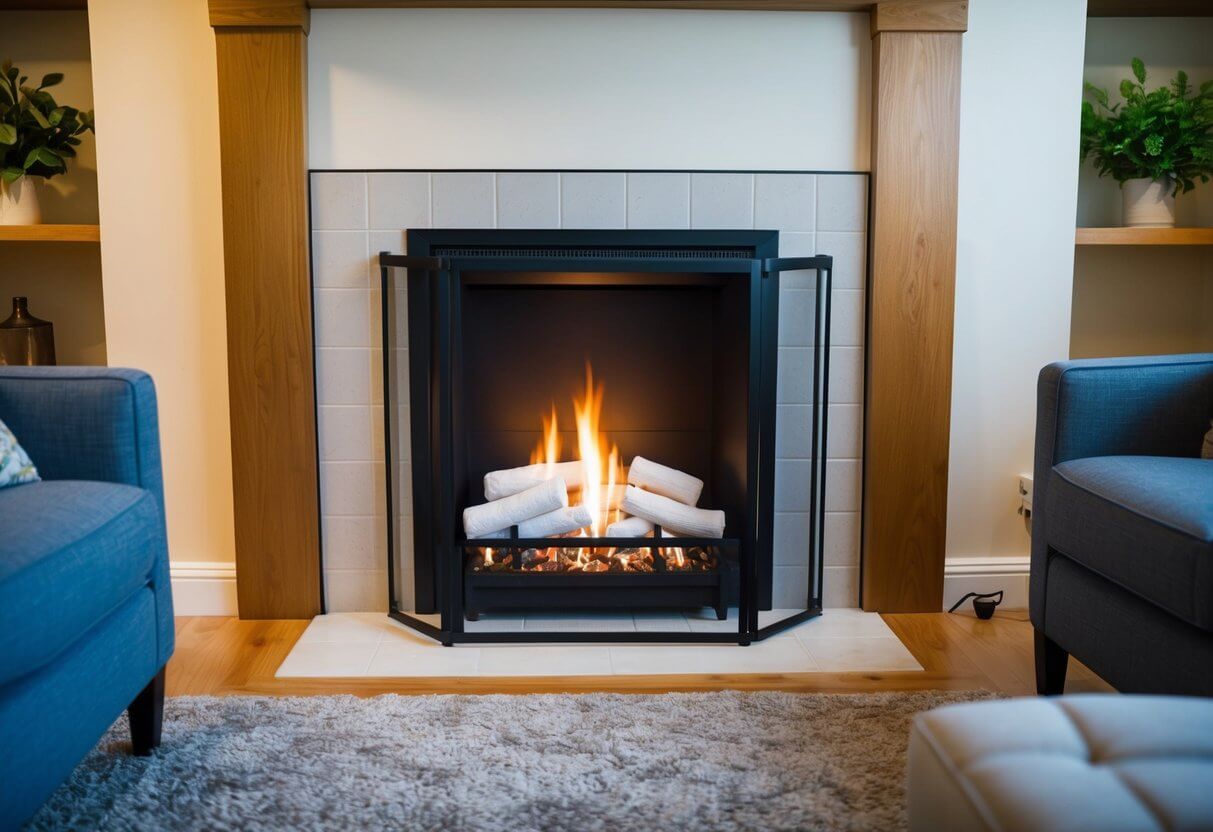
Gas fireplace logs come with essential safety features aimed at preventing hazards associated with gas use. Understanding these features can enhance user safety and ensure proper functionality.
Carbon Monoxide and Ventilation
Carbon monoxide (CO) is a potential hazard when using gas appliances. Proper ventilation is crucial to prevent harmful buildup. Gas fireplace logs should always be installed in areas with adequate airflow.
Users should ensure that exhaust vents are unobstructed and functioning properly. Regular checks of the chimney damper are essential to allow smoke and gases to exit the home.
Key Recommendations:
- Install a functional carbon monoxide detector in proximity to the gas fireplace.
- Monitor CO levels, especially in enclosed spaces.
Oxygen Depletion Sensor
An oxygen depletion sensor (ODS) is a critical safety feature for gas logs. This device automatically shuts off the gas supply when oxygen levels drop below a safe threshold, typically around 18%.
The inclusion of an ODS helps prevent asphyxiation and ensures the safety of individuals in the room. It’s important for users to regularly test the sensor to ensure it is operational. Following the manufacturer’s guidelines for maintenance can extend the sensor’s life.
Benefits of ODS:
- Provides an added layer of safety.
- Offers peace of mind for users.
Proper Installation
Proper installation of gas fireplace logs cannot be overstated. Incorrect installation can lead to safety hazards, including gas leaks and improper venting. It is advisable to have a licensed professional handle the installation.
They will ensure that the gas supply line and connections meet safety standards. An expert can also guarantee that all necessary safety features, such as the ODS and ventilation, are installed and functional.
Installation Tips:
- Always adhere to local codes and manufacturer instructions.
- Consider conducting regular maintenance checks to ensure optimal performance.
Heating Efficiency and Output
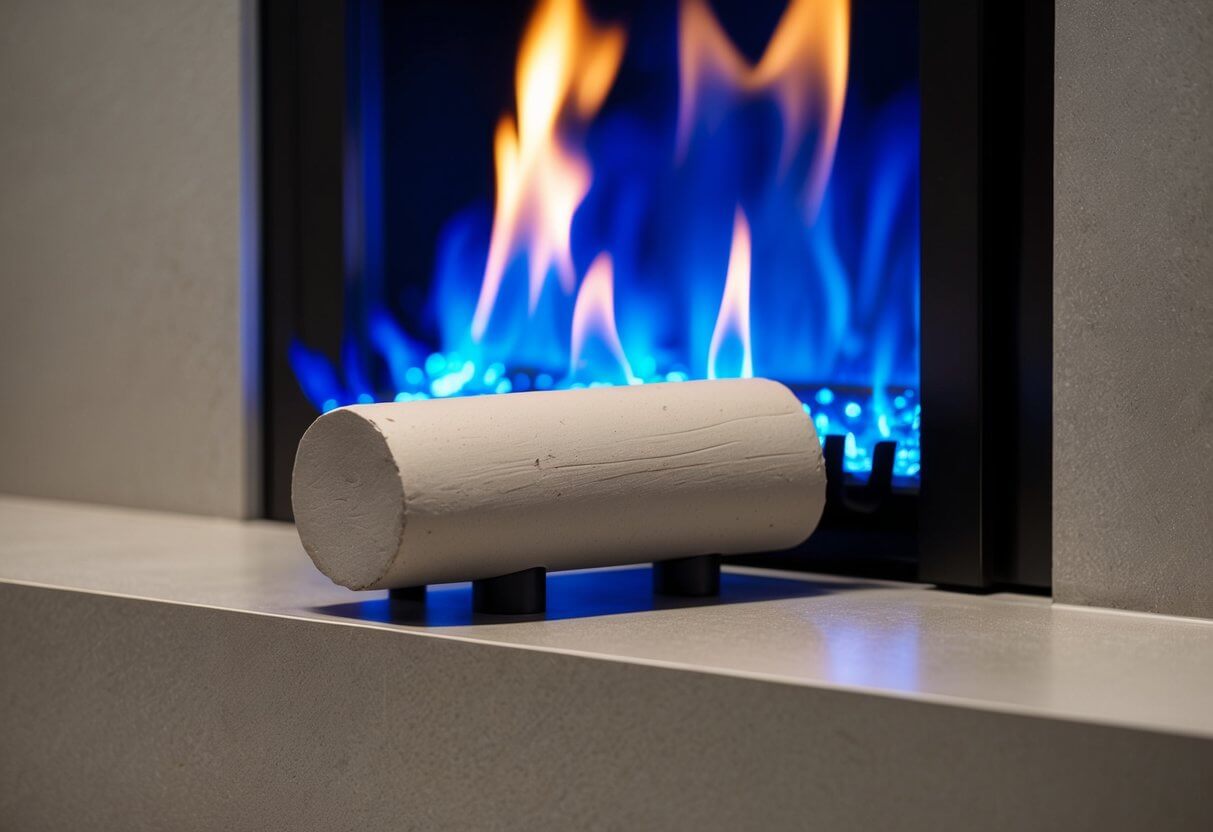
Gas fireplace logs provide effective heating solutions with efficiencies that can surpass traditional wood-burning fireplaces. Understanding the comparison of heat output and efficiency can guide consumers in their choice of gas log sets.
Comparison with Wood-Burning Fireplaces
Gas fireplaces generally offer higher efficiency than wood-burning options. While wood-burning fireplaces show efficiency rates between 10% and 30%, gas units can achieve 50% to 90% efficiency, particularly in ventless models.
Additionally, gas log sets eliminate the need for frequent wood chopping, storage, and the mess associated with ash cleanup. This can make them a more convenient option for homeowners who prioritize ease of use and cleanliness.
Gas options also provide more control over heat output compared to wood-burning fireplaces, allowing for consistent warmth.
BTUs and Heat Efficiency
The heat output of gas fireplaces is often measured in British Thermal Units (BTUs). Most efficient models output between 28,000 and 34,500 BTU/hour. Higher BTU ratings indicate greater heating power.
Efficiency can also be expressed through Annual Fuel Utilization Efficiency (AFUE) ratings. Many gas fireplace models boast an AFUE of 70% to 90%, translating to a significant conversion of fuel to heat. Vent-free logs, in particular, maximize heat retention, radiating warmth directly into the living space without venting losses.
Warmth and Cozy Ambiance
Gas fireplaces create a cozy ambiance that mimics traditional wood fires. The realistic appearance of ceramic logs enhances this atmosphere. These installations produce a steady flame that can warm an area without the fluctuations associated with burning wood.
Unlike wood-burning fireplaces, gas options don’t produce extensive smoke or emissions. This makes them suitable for indoor environments where air quality is a concern. Gas log sets not only offer warmth but also contribute to a welcoming and inviting space perfect for gatherings.
Installation, Operation, and Maintenance
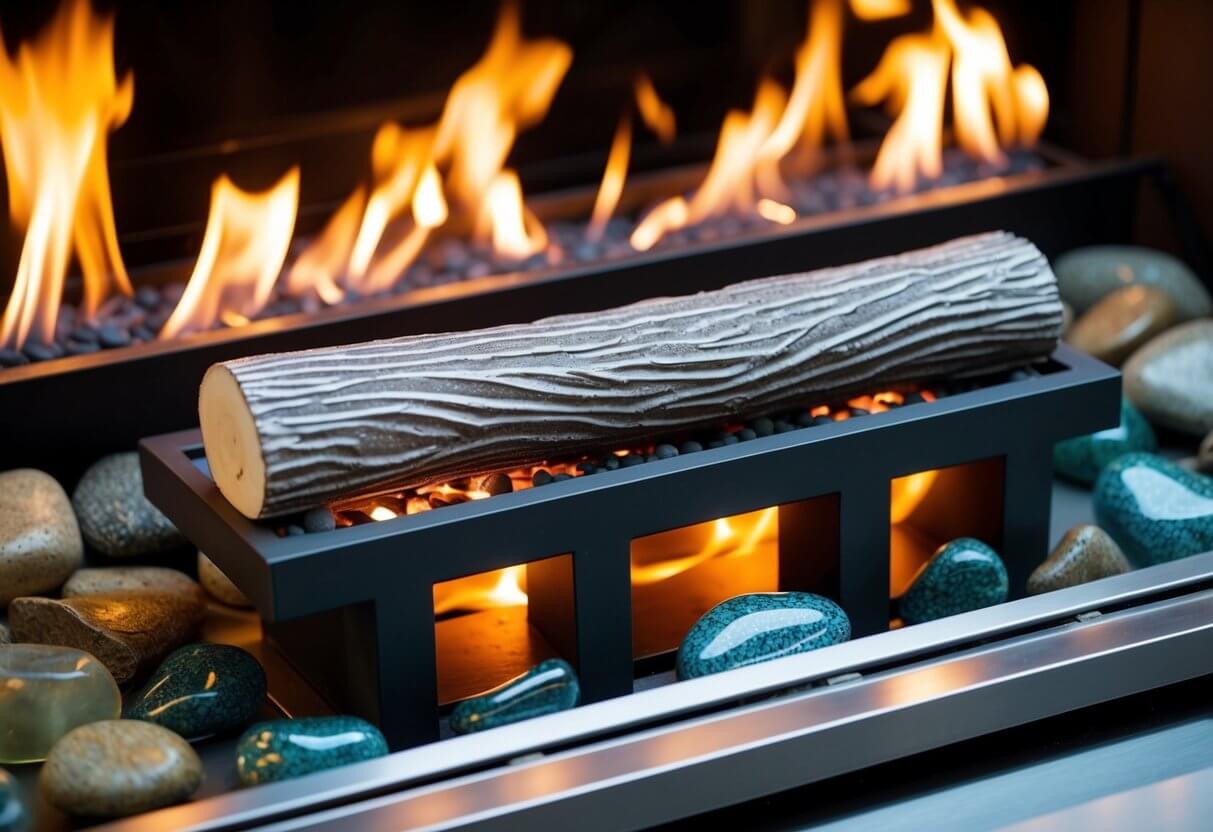
Proper installation, operation, and maintenance of gas fireplace logs are crucial for safety and efficiency. Understanding these elements ensures a reliable and enjoyable experience with gas log sets.
Setting Up Your Gas Log Set
Installing a gas log set requires careful attention to detail. The first step involves selecting a suitable firebox compatible with either natural gas or propane. It’s essential to follow the manufacturer’s guidelines for dimensions and venting.
Next, the gas supply line should be properly connected. This connection must be checked for leaks using a soap solution. Once secure, the logs can be arranged within the firebox, ensuring the burners are unobstructed. It is advisable to consult a professional installer or a licensed technician for the setup to ensure compliance with local codes.
Running Your Gas Fireplace
Operating a gas fireplace is straightforward. Most systems feature a remote control or wall switch for ignition, allowing users to easily start the flames. For optimal performance, the gas line pressure must be adjusted according to the manufacturer’s specifications.
Users should monitor the flame appearance; ideally, it should be blue with occasional yellow tips. If flames are yellow or excessively flickering, it may indicate insufficient air supply or blocked burners. Regular monitoring not only enhances comfort but also ensures safety during operation.
Regular Maintenance and Upkeep
Routine maintenance is necessary to keep gas logs functioning effectively over time. This includes checking the burners for blockages and cleaning them periodically. Employ a vacuum or a soft brush to remove any debris or soot buildup in the firebox.
Additionally, inspecting the gas lines for leaks is critical. Users can conduct a simple check by applying a soap solution to the connections. If bubbles form, it indicates a leak that needs immediate attention. Also, an annual professional inspection is recommended to ensure comprehensive safety and efficiency of the gas system.
Frequently Asked Questions
This section addresses common inquiries regarding gas fireplace logs. It covers materials used, maintenance considerations, and differences between various types of gas logs.
What is the best material for gas fireplace logs?
Gas fireplace logs are commonly made from refractory ceramic, ceramic fibers, or refractory cement. These materials are chosen for their fire-resistant properties and ability to mimic real wood appearance.
Do gas fireplace logs need to be replaced?
Gas fireplace logs may need replacement over time due to wear and tear. With proper maintenance, they can last many years, but signs of damage or significant discoloration suggest it is time for a new set.
What are the differences between vented and ventless gas logs?
Vented gas logs require a chimney or vent to allow smoke and gases to escape. Ventless logs operate without a chimney, using a special design to minimize combustion byproducts in the home. Both types have specific use cases and efficiency ratings.
Are ceramics the optimal choice for gas fireplace logs?
Ceramic logs offer excellent durability and heat resistance. They are often favored for their aesthetic qualities, resembling real wood very closely while maintaining safety standards for use in gas fireplaces.
Can gas fireplace logs resemble real wood?
Manufacturers design gas logs to closely mimic the look of real wood. They use actual wood molds to create lifelike textures and shapes, enhancing the visual appeal of gas fireplaces.
Are there any health concerns associated with materials used in gas fireplace logs?
Generally, the materials used in gas fireplace logs are safe when used correctly. However, venting is crucial with vented logs to avoid indoor air quality issues. Regular maintenance reduces risks associated with potentially harmful byproducts.

